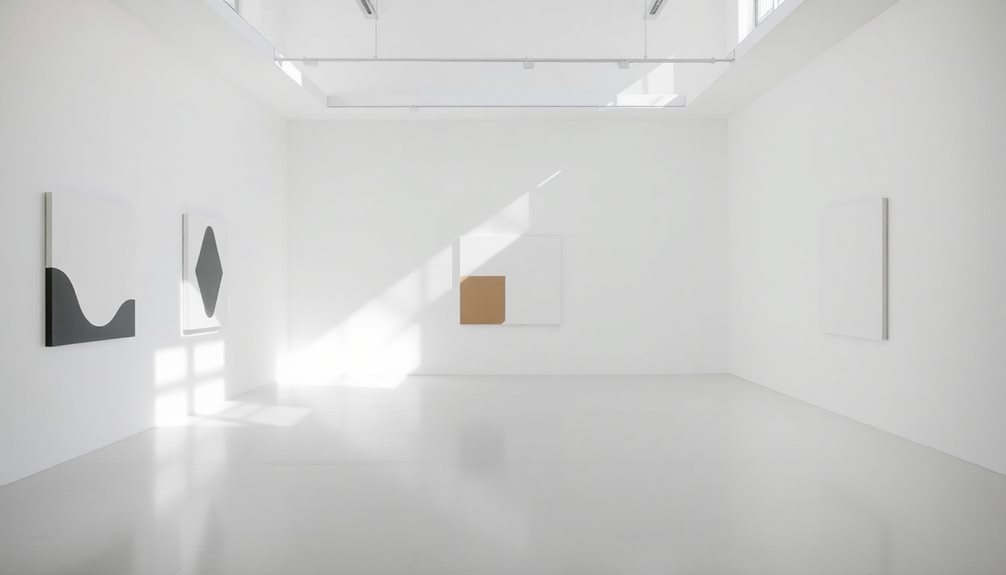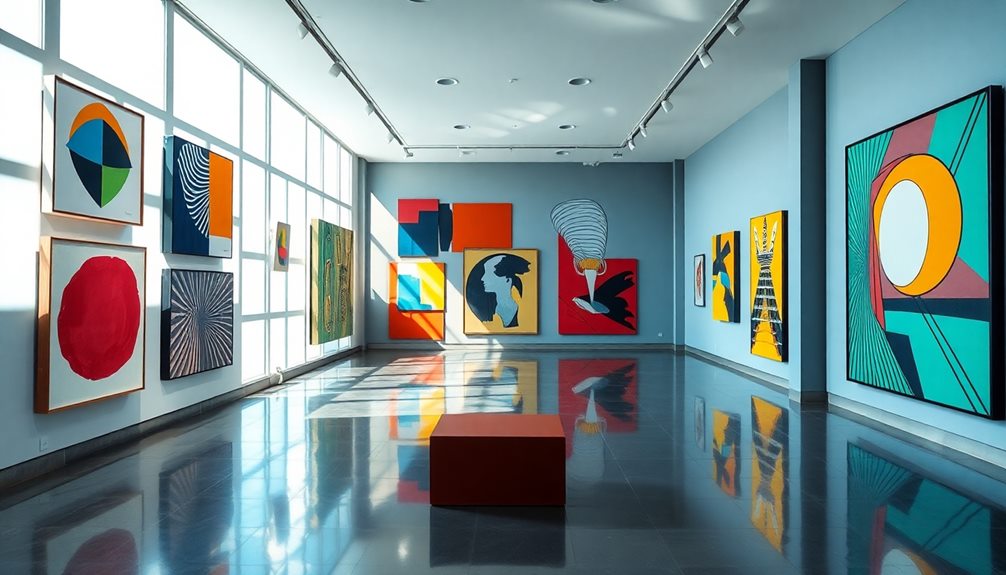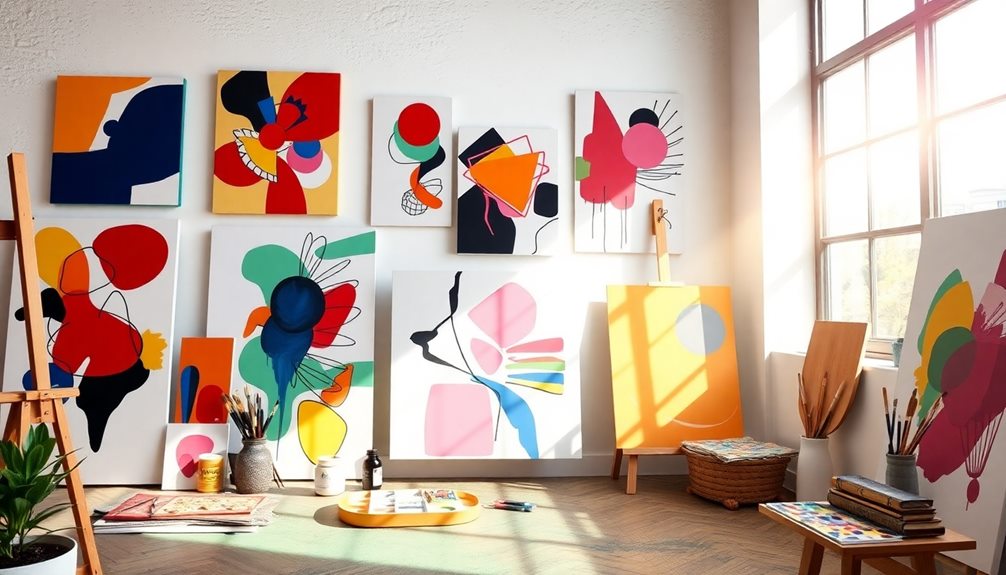In formalist art theory, space and balance are crucial for how you perceive and interpret visual art. Artists manipulate positive space—where the main subjects reside—and negative space, which enhances the overall impact. This interplay creates depth, guiding your eye and emotions. Balance is achieved through the careful arrangement of colors, shapes, and lines, making the composition cohesive. Techniques like overlapping and atmospheric perspective add layers to your experience. By understanding these elements, you can appreciate the aesthetic qualities that define formalist works. Want to explore how these concepts influence specific pieces and artists?
Key Takeaways
- Formalist art theory prioritizes the manipulation of space and balance, emphasizing intrinsic elements over narrative content.
- Positive space contains the main subjects, while negative space enhances visual impact and interpretation.
- Balance in composition is achieved through careful arrangement of color, shape, and line, influencing viewer engagement.
- Techniques like overlapping and atmospheric perspective create depth and evoke emotional responses in viewers.
- Understanding spatial relationships enhances appreciation of formal structure and aesthetic qualities in artworks.
Introduction

Formalist art theory emphasizes the significance of space and balance in visual art, focusing on how these elements contribute to the overall aesthetic experience.
In this framework, space isn't just a backdrop; it's manipulated through techniques like perspective and composition, guiding your viewer perception. You'll notice how artists play with positive and negative space to create depth, which invites you to engage more deeply with the artwork.
Balance is another crucial element in Formalism. Artists arrange components within their pieces to achieve visual harmony, prioritizing the intrinsic qualities of color, line, and form over narrative context.
This approach enhances your appreciation of the work's formal structure, allowing you to experience the aesthetic qualities more profoundly.
Key Concepts and Definitions

What makes Formalism distinct in the realm of art theory? At its core, it emphasizes the manipulation of space surrounding the formal elements of an artwork. Artists use techniques like perspective and composition to create depth, guiding your eye and enhancing your viewing experience.
In this context, positive space refers to the main subjects of the composition, while negative space, the area that surrounds these subjects, plays a crucial role. It can enhance interpretation and emotional impact, making the relationship between the two essential for understanding the artwork.
Balance in Formalist art is all about arranging elements like color, shape, and line to achieve visual harmony and stability. This balance is critical for providing an overall aesthetic experience that resonates with you.
Formalist critics often delve into the interplay of these spatial relationships, examining how they influence your appreciation and understanding of the piece. By strategically using space and balance, artists evoke various emotions, drawing you deeper into the artwork.
In this way, Formalism not only shapes the visual experience but also enriches your engagement with art itself.
Essential Elements of Composition

Composition in art serves as the backbone of any successful piece, shaping how you perceive and interact with the visual elements. In formalist art theory, the arrangement of these elements—line, shape, and color—plays a vital role in achieving balance. You'll notice that positive space contains the main subjects of the artwork, while negative space surrounds them, enhancing the overall visual impact. This interplay is essential for a harmonious composition.
Artists skillfully manipulate spatial relationships through techniques like overlapping and perspective, guiding your eye and creating a sense of depth. The scale of objects also influences your perception, affecting how you relate to them within the composition. This relationship contributes significantly to the emotional resonance of the artwork.
Formalist critics focus on how the structure of the composition, rather than context or narrative, determines its effectiveness and aesthetic value. By analyzing these essential elements, you can appreciate the intricate balance that artists strive to achieve.
Understanding these components equips you with the tools to engage more deeply with art, allowing you to recognize the thought and intention behind each piece.
Notable Formalist Artworks

While exploring notable artworks within the realm of formalist art theory, you'll encounter pieces that vividly demonstrate the principles of composition and design. Piet Mondrian's "Composition with Red, Blue, and Yellow" stands out with its bold use of geometric shapes and primary colors, emphasizing balance and spatial relationships.
In contrast, Kazimir Malevich's "Black Square" radically departs from representational art, compelling you to reconsider the essence of painting through its focus on form and space.
Jackson Pollock's "No. 5, 1948" showcases the manipulation of space with his drip technique, creating a dynamic composition that prioritizes the physicality of paint over narrative content.
Meanwhile, Henri Matisse's "The Dance" employs vibrant colors and flowing forms to evoke movement and balance, illustrating the emotional impact of spatial arrangement in Formalism in Modern art.
Lastly, Wassily Kandinsky's "Composition VII" integrates color, line, and form, creating a complex interplay of spatial dimensions that reflects his belief in the spiritual and emotional resonance of abstract art.
Collectively, these notable formalist artworks challenge viewers' perception and invite deeper engagement with their elements.
Tips and Best Practices

How can you effectively enhance your understanding of formalist art? Start by focusing on the manipulation of positive and negative space. This understanding is crucial, as it directly influences the overall composition and emotional impact of the artwork.
Pay attention to how artists use techniques like overlapping and atmospheric perspective to create depth and balance in their pieces.
Next, analyze the spatial relationships between objects. This will help you appreciate the arrangement and balance that contribute to the work's intrinsic value.
Consider how scale relates to the surrounding space, as this enhances your perception and engagement with the artwork's formal qualities.
As you explore various artworks, notice how a balanced composition can evoke specific emotional responses. Observe how the arrangement guides the viewer's eye, reinforcing the significance of spatial dynamics.
Take the time to reflect on how these elements interact within the artwork, allowing you to deepen your appreciation for formalist art.
Viewer Engagement and Interpretation

Viewer engagement in formalist art is deeply tied to how space and balance are manipulated within a piece. As you observe a work, the arrangement of positive and negative space guides your eye, shaping your interpretation of the composition. This careful orchestration of elements allows you to appreciate the relationships within the artwork, fostering a deeper connection.
Art critics emphasize the technical aspects of space, noting how perspective and depth contribute to the overall emotional impact. When you understand these spatial relationships, you gain insights into the artist's intention, revealing how balance and tension are created through compositional strategies. This knowledge enriches your experience, allowing you to engage more fully with the piece.
The effective use of space doesn't just define the physical characteristics of the artwork; it also evokes specific emotional responses. As you navigate through the composition, you might feel a sense of harmony or discord, depending on how the artist has arranged the elements.
Ultimately, this dynamic interaction enhances your viewer engagement, transforming a simple observation into a profound aesthetic experience.
Perception of Spatial Relationships

Spatial relationships in formalist art hinge on the interaction between positive and negative space, fundamentally shaping your perception of a piece. Positive space, occupied by the main subjects, contrasts with the surrounding negative space, which defines and enhances those subjects.
Artists use techniques like overlapping and atmospheric perspective to create depth, allowing you to experience these spatial relationships more fully within the composition.
When formalist critics analyze artwork, they focus on how elements of perspective and composition construct a cohesive visual experience, independent of external context. The interplay between scale and spatial relationships can significantly affect your emotional response; larger forms may dominate negative space, altering the overall balance and your perception of the piece.
Understanding these dynamics is essential for appreciating the formal qualities of any artwork. They reveal the artist's intent and technical skill in guiding your eye and creating depth.
As you engage with formalist art, consider how the arrangement of positive and negative space impacts your interpretation, allowing you to experience the artwork's spatial relationships more profoundly.
Additional Resources

To deepen your understanding of formalist art theory, exploring additional resources can be incredibly beneficial. Start by examining foundational texts on formalism, which emphasize the manipulation of space within a composition. These works often detail how positive and negative space contribute to balance, guiding your perception as a viewer.
You should also look for articles and critiques that analyze specific artworks through a formalist lens. These resources will help you appreciate how artists use techniques like overlapping and atmospheric perspective to create depth, enhancing your understanding of spatial dynamics. By doing this, you'll see how these elements contribute to the overall composition without relying on narrative content.
Art criticism centered on formalism can further illuminate the relationship between form, line, and space. These discussions are essential for grasping the formal qualities that shape a piece's aesthetic impact.
Additionally, engaging with visual resources, such as exhibitions or documentaries, can provide practical insights into how balance is achieved in various artworks.
Frequently Asked Questions
What Is Space and Balance in Art?
Space in art refers to the distance between objects, shaping how you perceive them. Balance involves the arrangement of elements to create harmony. Together, they influence your emotional response and appreciation of the artwork's overall impact.
What Is the Space in Art Theory?
Space in art theory refers to the arrangement and distance between objects. You'll notice how positive and negative spaces interact, shaping your perception. Techniques like overlapping and perspective create depth, enhancing your overall experience of the artwork.
What Is the Theory of Balance in Art?
The theory of balance in art focuses on distributing visual weight to achieve harmony. You can create symmetrical balance with mirrored elements or asymmetrical balance by combining differing elements, guiding the viewer's eye and evoking emotions.
What Are the Elements of Formalism in Art?
You'll find that formalism in art emphasizes color, line, shape, texture, and space. It values these visual elements for their own sake, focusing on their arrangement and impact rather than any narrative or emotional content.
Conclusion
In exploring space and balance in formalist art theory, you've gained valuable insights into how these elements shape visual experiences. By understanding key concepts, essential composition elements, and notable artworks, you can enhance your appreciation of art. Remember to apply the tips and best practices for engaging with art, as well as recognizing spatial relationships. With these tools, you're now better equipped to interpret and enjoy the richness of formalist art in your own way. This newfound knowledge allows you to approach artworks with a deeper sense of curiosity and admiration, fostering a more meaningful connection to the pieces you encounter. By focusing on the elements of formalist art analysis, such as line, shape, color, and texture, you can uncover the deliberate choices artists make to convey emotion and structure. Let this understanding inspire not only how you view art but also how you articulate your thoughts and feelings about it, enriching your overall experience.









